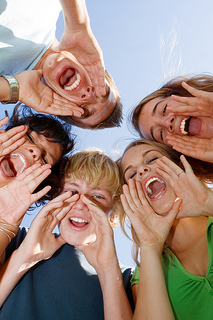April 29th, 2014

Dental visits are often negatively associated with discomfort in many people’s minds. But at Pioneer Dental, Dr. Carl Meyers and our team have created an atmosphere focused on dispelling those myths. Our team is truly passionate about dentistry, and we are trained to gently accommodate each individual patient’s needs, with every procedure and visit performed with the utmost focus on your comfort.
If you are a patient of record at Pioneer Dental, we are committed to your oral health and are available to you. If you would like to learn more about stress-free dentistry at our West Bend, WI office, or to schedule an appointment, we encourage you to give us a call!
April 22nd, 2014

Earth Day began in 1970 as an event to raise awareness of our environment. What began as a single day in April is now recognized around the world to bring attention and education to global environmental issues. Conserving our natural resources, reducing water and air pollution, and developing green technologies are all ways in which we can improve the environment around us.
Reduce, Recycle, and Reuse
One of the easiest ways to participate in Earth Day is by simply reducing the amount of refuse that ends up in landfills. Many communities have recycling programs for paper, plastic, and metal refuse. By keeping recyclable items out of landfills, we reduce the need for new disposal space and the amount of energy needed for burning refuse. Recycling products also helps conserve the resources that are used in making new products.
You can save money by reducing your consumption of many everyday products. Single disposable water bottles can be recycled but they are costly. By using filtered faucet water, you can conserve your financial resources. Disposable paper towels can also be wasteful. Consider reusable cleaning rags for the majority of your chores.
Reusing items saves both the environment and your finances. A large number of products can be re-purposed to create a new item. Old furniture can be remade into a new piece. Old clothing can be used for craft items. If you are not able to find ways to reuse your old items, donate them to a charity. Remember to continue your positive environmental steps on a daily basis.
Other things you can do to improve the environment
Everyone, young or old, can find ways to participate in improving the environment. Some ideas include:
- Planting trees
- Picking up litter
- Reducing energy consumption
- Walking, bicycling, or carpooling to work or school
- Disposing of hazardous waste properly
- Using rain barrels to conserve water for plants
Earth Day is designed to appreciate and celebrate the health of the earth. Keeping the earth healthy is important, but keeping your mouth healthy is important, too. Healthy teeth and gums contribute to your overall health and well-being, so remember to call our team at Pioneer Dental to schedule an appointment. Have a happy and healthy Earth Day, from Dr. Carl Meyers!
April 15th, 2014

When patients of Pioneer Dental hear any mention of oral or dental hygiene, they probably think of brushing and flossing their teeth. Although these are extremely important, the term dental hygiene encompasses much more than that. Your mouth’s health, including your teeth, has an important impact on your overall physical health. The National Institute of Dental and Craniofacial Research published the surgeon general's first ever report on dental health. It is called A National Call to Action to Promote Oral Health. In that report, the Surgeon General states that the 1948 World Health Organization expanded its earlier definition of health to "a complete state of physical, mental, and social well-being, and not just the absence of infirmity."
The Importance of Oral Health to Total Overall Health
One of the most important themes that the dental health report stressed is that you cannot be healthy without oral health. It went on to explain that oral health and general health are inextricably linked, and therefore can't be seen as two separate things. Because oral health is so critical to overall health, it should be included in all community health programs. For individuals, this means that it is just as important to take care of your mouth, your teeth, and your overall oral health as it is to take care of the rest of your body. The two most prevalent dental diseases are caries (cavities), also known as tooth decay, and periodontal (gum) disease.
Ways that Oral Health Impacts Overall Health
One important way in which good oral health contributes to better overall health is seen in the findings of several studies in which the blood sugar levels of diabetic patients were significantly lowered when their periodontal (or gum disease) was successfully treated. Your mouth has roughly 500 different species of bacteria. Many are harmless, and some are even good bacteria that help maintain the balance of your intestinal flora. Harmful bacteria can infect your gums, causing gingivitis. Your body's immune system may try to fight off the alien invaders, but they attack your gums, causing inflammation and bleeding when you brush.
Now that you know how important good dental hygiene is, be sure to see to get your teeth cleaned every six months, have regular dental checkups, brush and floss your teeth at least twice daily, and replace your toothbrush at least every couple of months. Call us to schedule your next appointment at our convenient West Bend, WI location.
April 8th, 2014

When it comes to straightening your smile, our team at Pioneer Dental knows that having a mouth full of metal braces may not be your idea of fun. Luckily for you, Dr. Carl Meyers can offer a cosmetic alternative: Invisalign!
Using a series of clear, comfortable, and completely customized aligners, you can get the smile you’ve always wanted without traditional braces.
Since Invisalign aligners are discreet, they’re hardly noticeable when you speak and smile, and because they’re removable, you can eat and drink whatever you want. Just remember to brush and floss before putting your aligners back in! Treatment with Invisalign is just as effective as with metal braces, and the results are just as amazing!
If you want to know more about Invisalign, contact our West Bend, WI office to schedule an appointment.







